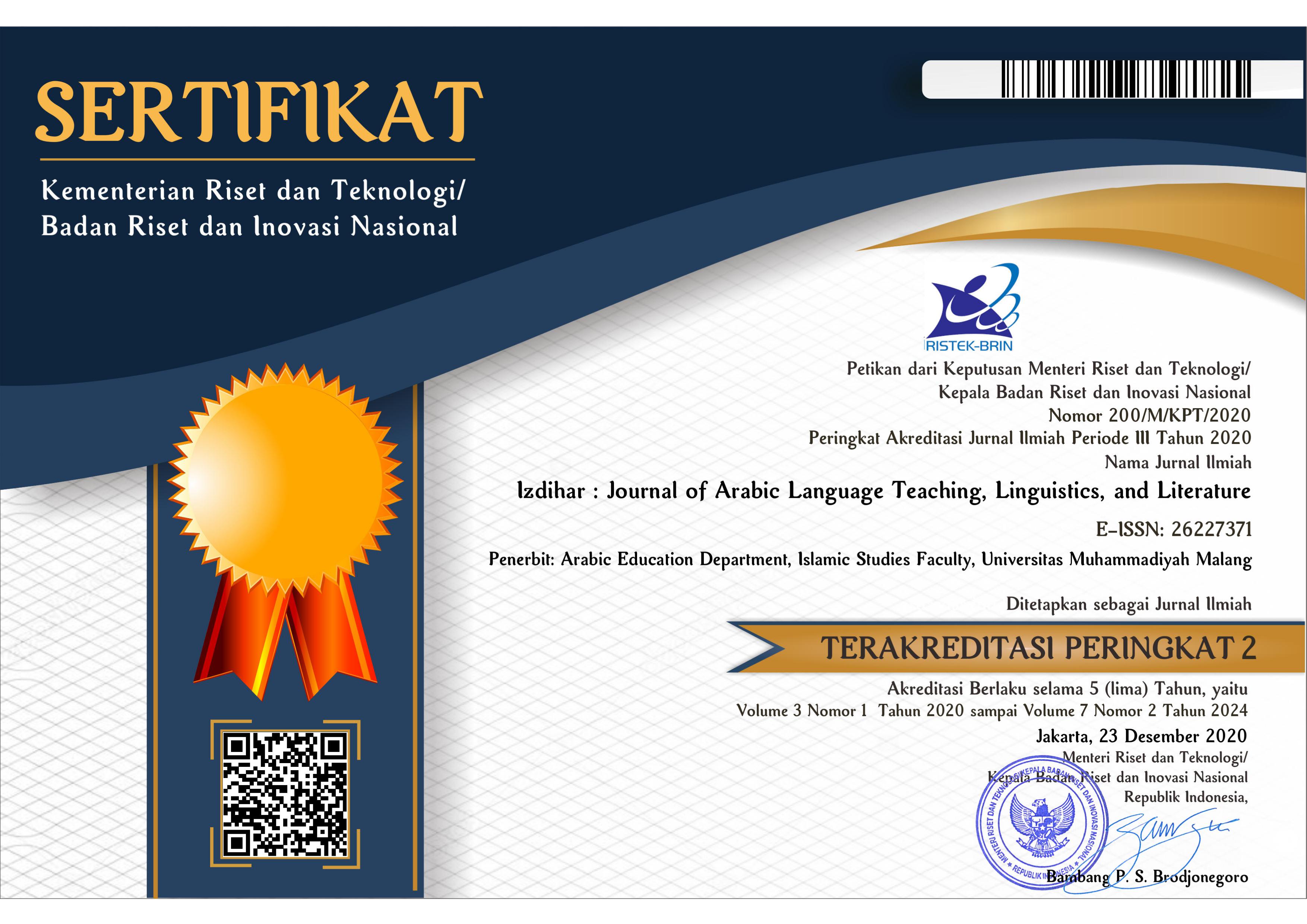Interrogative Sentence: A Contrastive Study of Arabic and Indonesian
DOI:
https://doi.org/10.22219/jiz.v2i3.10148Keywords:
Contrastive Analysis, Interrogative Sentence, Second Language LearningAbstract
Involving first language (L1) in second language learning (L2) is considered as an effective method to be practiced. This research focuses on a contrastive study between Arabic and Indonesian. It aims to investigate similarities and differences of the two languages, especially about their interrogative sentence forms. It is descriptive qualitative research which applies two methods; observation and introspection method. Then, Contrastive Analysis (CA) is used to analyze the data. The result shows that similarity concept between Arabic and Indonesian is many shown on matā, ayna, limādzā, and hal. Meanwhile, differences between both of them are shown on mā, man, ayy, and kayfa. As a result, it may occur errors in the use of question, errors in translating interrogative sentence, and errors in understanding question.Downloads
References
Adila, W. (2019). ‘A Written Grammatical Error Analysis of Second Year Students of Arabic’, Arabi: Journal of Arabic Studies, 4(1), 31-44. DOI: http://dx.doi.org/10.24865/ajas.v4i1.141.
Al Ajlouny, M. (2007). ‘Contrastive Analysis and Diglossia’, International Journal of Arabic-English Studies (IJEAS), Vol. 8
Al Fauzan, A.I., Husain, M.T., Fadhil, M.A.K.M. (2003). Al ‘Arabiyyah Baina Yadaik 1. Riyadh: Al Maktab Ar Ra’isy Al ‘Arabiyyah lil Jami’ Al Waqful Islamiy.
Al Ghalayini, M. (2009). Jāmi’ ad Durūs al ‘Arabiyyah. Beirut: Dar al Kutub al ‘Ilmiyah.
Al Khresheh, M. H. (2016). ‘A Review Study of Contrastive Analysis Theory’, Journal of Advances in Humanities and Social Sciences, 2(6), 330-338. DOI: http://doi.org/10.20474/jahss-2.6.5.
Badan Pengembangan Bahasa dan Perbukuan. (2019). Kamus Besar Bahasa Indonesia (KBBI). Retrieved November 23, 2019, from https://kbbi.kemdikbud.go.id
Brosh, H. Y. (2019). ‘Arabic language-learning strategy preferences among undergraduate students’, Studies in Second Language Learning and Teaching, 9(2), 351-377. DOI: https://doi.org/10.14746/ssllt.2019.9.2.5.
Dost, E. N. (2017). ‘A Review of Contrastive Analysis Hypothesis with a Phonological and Syntactical View: A Cross Linguistic Study’, The Buckingham of Language and Linguistics, 10, 32-41. DOI: http://dx.doi.org/10.5750/bjll.v10i0.1482.
Els, T. V., Bongaerts, T., Extra, G., Van Os, C., & Van Dieten, A. M. J. (1991). Applied Linguistics and the Learning and Teaching of Foreign Languages. Great Britain: Edward Arnold Publishers.
El Majid, W.A.E.A & Ahmed, M.A. (2016). ‘A Contrastive Analysis of English and Arabic Translation Problems’, Journal of Humanities, 17(4), 131-144.
Enein, Sameh, A. (n.d.) ‘Language and Cultural Diplomacy: Arabic’, Ambassador Speech on UN Library Talks Geneva. Retrieved November 23, 2019, from https://www.unog.ch/unog/website/library.nsf.
Firdaus, M. (2019). ‘Problems in Expressing Arabic Language of Indonesian Students at Khartoum International Institute for Arabic Language’, Izdihar: Journal of Arabic Language Teaching, Linguistics, and Literature, 2(1), 35-52. DOI: https://doi.org/10.22219/jiz.v2i1.7588.
Fauziati, E. (2014). ‘Contrastive Analysis, Transfer Analysis, Error Analysis, and Interlanguage: Four Concepts One Goal’, ADJES: Ahmad Dahlan Journal of English Studies, 1(1-2), 9-21.
Fatoni, A. (2019). ‘Arabic Learning for Academic Purposes’, Izdihar : Journal of Arabic Language Teaching, Linguistics, and Literature, 2(2), 139-152. DOI: https://doi.org/10.22219/jiz.v2i2.10096.
Hasan, R. (2018). ‘Implikasi Analisis Kontrastif Kalimat Bahasa Arab dan Bahasa Indonesia dalam Meningkatkan Pemahaman Siswa’, Jurnal Shaut Al ‘Arabiyah, 6(1), 105-113. DOI: https://doi.org/10.24252/saa.v6i1.4801
Huda, K. (2019). ‘Perbandingan Struktur Obyek pada Bahasa Arab dan Bahasa Indonesia: Penelitian Analisis Kontrastif dalam Koran Al-Jazirah dan Koran Tempo’, Al Fathin: Jurnal Bahasa dan Sastra Arab, 2(1), 111-120. DOI: https://doi.org/10.32332/al-fathin.v2i2.1546
Khansir, A. A. (2012) ‘Error Analysis and Second Language Acquisition’, Theory and Practice in Language Studies, 2(5), 1027-1032. DOI: https://doi.org/10.4304/tpls.2.5.1027-1032.
Lado, Robert. (1957). Linguistics Across Cultures. Ann Arbor: The University of Michigan Press.
Lekova, B. (2010). ‘Language Interference and Methods of Its Overcoming in Foreign Language Teaching’, Trakia Journal of Sciences, 8(3), 320-324.
Lindawati. (2016). ‘Indonesian Interrogative Sentences: a Study Forms and Function’, Jurnal Humaniora, 28(3), 348-357. DOI: https://doi.org/10.22146/jh.22289.
Masqon, D. (2018). ‘Daur al Lughah al Arabiyyah fī ‘Ashr al ‘Aulamah wa Tathbīqihā fī Tathwīr al ‘Ulūm’, Izdihar : Journal of Arabic Language Teaching, Linguistics, and Literature, 1(1), 25-64. DOI: https://doi.org/10.22219/izdihar.v1i1.6562.
Momani, M. M. & Al Taheer, A. Muneer. (2015). ‘A Contrastive Analysis of English and Arabic from a Syntactical Perspective’, Canadian Open English and Literature Journal, 2(1), 1-8.
Nikmah, K. (2019). ‘Meaning Variations of Qāla (قال) in Indonesian Language,’ Izdihar: Journal of Arabic Language Teaching, Linguistics, and Literature, 2(2), 77-100. DOI: https://doi.org/10.22219/jiz.v2i2.9909.
Nur, T. (2016). ‘Analisis Kontrastif dalam Studi Bahasa’, Arabi: Journal of Arabic Studies, 1(2), 64-74. DOI: https://doi.org/10.24865/ajas.v1i2.11.
Omar, T. (2017). ‘Culture and Second Language Acquisition: Arabic Language as A Model’, European Scientific Journal, 13(2), 159-166. DOI: https://doi.org/10.19044/esj.2016.v13n2p159.
Qodri, M. (2019). ‘Lexical Phenomenon in Linguistics Theories’, Izdihār: Journal of Arabic Language Teaching, Linguistics, and Literature, 2(1), 1-16. DOI: https://doi.org/10.22219/jiz.v2i1.8326.
Rabab’ah, G. & Bulut, D. (2007). ‘Compensatory Strategies in Arabic as A Second Language’, Poznań Studies in Contemporary Linguistics, 43(2), 83–106. DOI: https://doi.org/10.2478/v10010-007-0020-5.
Rustipa, K. (2011). ‘Contrastive Analysis, Error Analysis, Interlanguage, and the Implication to Language Teaching’, Ragam: Jurnal Pengembangan Humaniora, 11(1), 16-22.
Sabbah, S. S. (2015). ‘Negative Transfer: Arabic Language Interference to Learning English’, Arab World English Journal, (4), 269-288. http://dx.doi.org/10.2139/ssrn.2844015.
Saidah. (2011). ‘Studi Kontrastif antara Adawat al Istifham dalam Bahasa Arab dan Question Words dalam Bahasa Inggris’, Unpublished Master’s theses. Universitas Islam Negeri Alauddin Makassar.
Parera, J. D. (1997). Linguistik Edukasional. Jakarta: Penerbit Erlangga.
Umami, M. (2015). ‘A Contrastive Analysis of Interrogative Sentences in English and Indonesian’, Register Journal, 8(2), 151-260. DOI: https://doi.org/10.18326/rgt.v8i2.151-162.
Downloads
Published
How to Cite
Issue
Section
License
Copyright Notice
Authors who publish with this journal agree to the following terms:
- Authors retain copyright and grant the journal right of first publication with the work simultaneously licensed under a Creative Commons Attribution-ShareAlike 4.0 International License that allows others to share the work with an acknowledgment of the work's authorship and initial publication in this journal.
- Authors are able to enter into separate, additional contractual arrangements for the non-exclusive distribution of the journal's published version of the work (e.g., post it to an institutional repository or publish it in a book), with an acknowledgment of its initial publication in this journal.
- Authors are permitted and encouraged to post their work online (e.g., in institutional repositories or on their website) prior to and during the submission process, as it can lead to productive exchanges, as well as earlier and greater citation of published work (See The Effect of Open Access).
Copyright (c) 2019 Izdihar : Journal of Arabic Language Teaching, Linguistics, and Literature

This work is licensed under a Creative Commons Attribution-ShareAlike 4.0 International License.

















